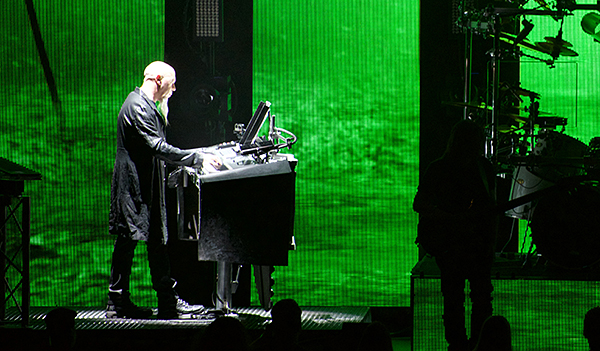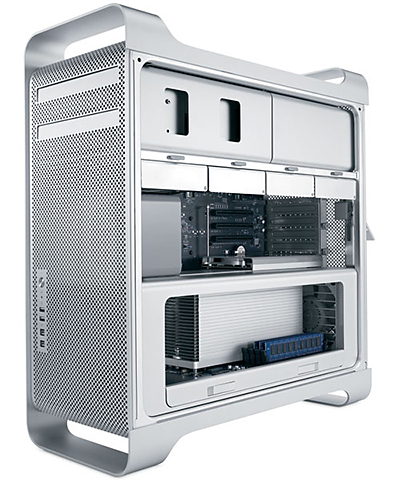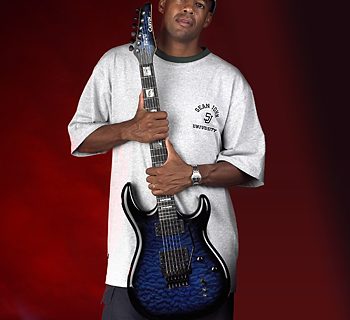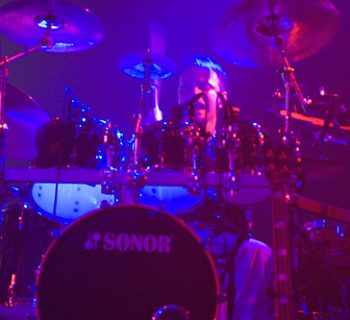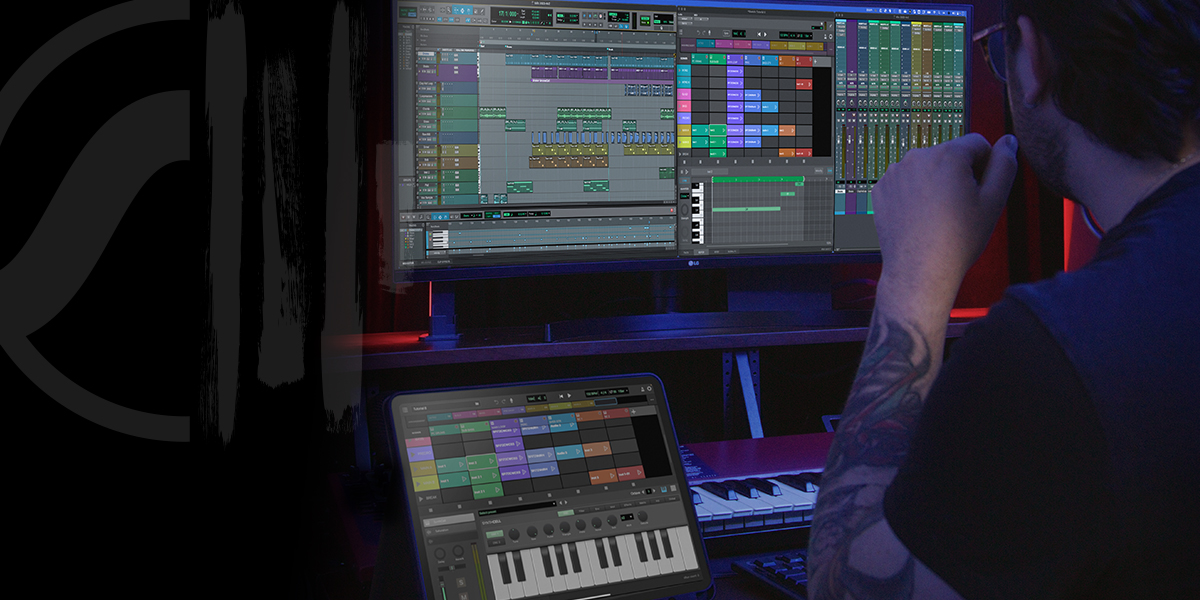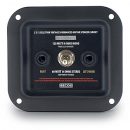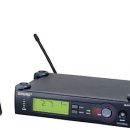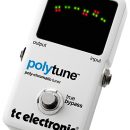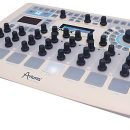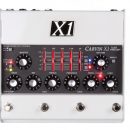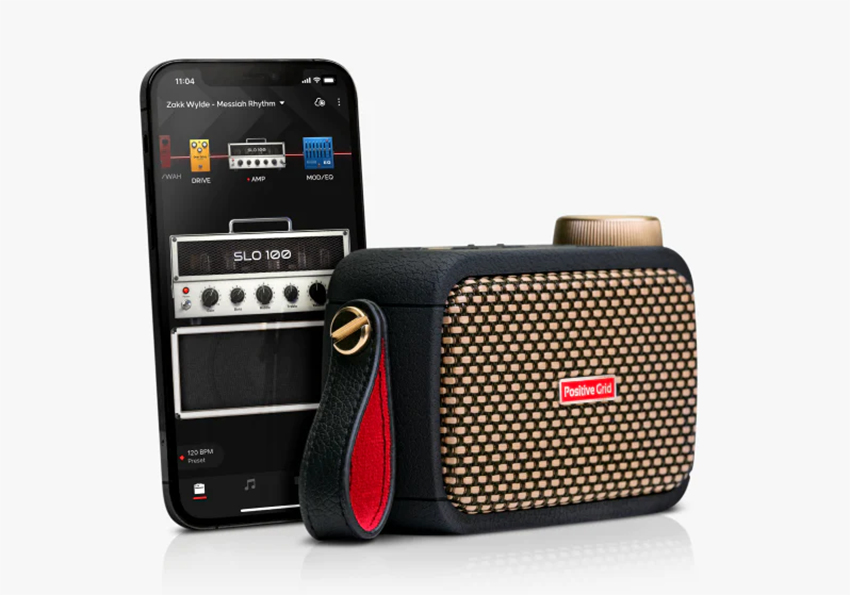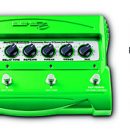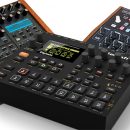I’ve got an orchestra in my pocket. Let me take it out right now.
JR: You got a million questions for me?
MPc: Yes!
JR: Then let’s begin. [laughs]
MPc: Let’s start with how The Astonishing came together.
JR: Well… You know, ever since we did that first concept album, Scenes From a Memory, which was my first album with Dream Theater, we’ve wanted to revisit the idea of doing a concept album, because it was cool and prog bands, you know, who else is going to do concept albums? I mean, really.
But we needed to leave some distance between the first one and another one. And it might have been a good time to do one maybe like five, six years ago, but of course we had a major shakeup at that point, with Portnoy leaving and Mangini joining. So that wasn’t really a good time. That was a good time to solidify things with the band and do things that would allow people to know that we’re going on without any problems and everything’s cool.
But moving more towards now, it has become a good time to do this and there was one thing that was really very much on our minds, and especially on John Petrucci’s mind, because he knew he was going to write this story. He wanted to do something that was deeper, more like a real story, something that he could really stand behind, that was well-developed.
So, Scenes From a Memory of course is a classic album, everybody loves it. But it was a loose kind of a concept. It left a lot open for interpretation, and it was what it was.
But now, this new story is something that is very developed because it has the makings of, kind of, a classic story. It’s got all the different elements. John studied classic stories to even be able to write this, and spent a lot of time on it.
So we had that in mind and, about two-and-a-half years ago, he started to work on it. At the end of the last world tour, he presented the idea again. We started to talk about, “Okay, guys, it’s time to do a new album. I’ve got this idea for a concept album.” So he gave me this synopsis that he wrote to read. And I read it. It was just backstage in some venue and I thought, “Wow. Pretty cool. I like this.” It inspired me. And I read it again and a few times, I took it home. And at that point we said, “Okay, yeah, let’s work on this. This is really cool.”
So, it inspired me and I started to sit at the piano and started to write a lot of different music. Kind of voice notes, using my iPhone, like I play something—Oh, that’s cool, and I’d record a minute of it, I’d send it to him. And pretty soon we had a whole collection of stuff from me. And he’d had a bunch of themes that were running through his head when he was writing the story, too. So our first get-togethers were kind of like looking at all those ideas and a combination of going through his themes and I had to harmonize them and bring them to a point where we could record just the whole thing with chords and everything.
But then it was more about just kind of saying, Okay, well, these are our characters, this is our story. Which one of these many, many ideas—which ones are we going to use? So we would go through and we would pick and we’d find one idea that we had that could work for the story. And then, of course, coming up with new things.
So it started out kind of casual, with me going to his home studio, him coming to my home studio. Quickly evolved to another stage which was, okay, we’ve got to get together a little bit more often. This is pretty serious. We also felt going into this that this album had to be done in a different way than any other album, because this album was more detailed. It was totally story driven, and the composition of it had to be very specific. And, in order to accomplish that, we decided that the best way to do it was for him and I to go into a studio and just write and compose this album. Not go and do it like the other way that we’ve done things, which is to go into a live room with all the guys and just kind of hash out stuff and do it that way.
But this was… and so this was great… We went in. We eventually booked studio time to where we could sit with my keyboards, his guitar, a computer, and just do this. And we would literally have morning meetings every morning. He’d be working on the story, but we would look at what our goal was for the day, where the story was at, which characters were involved, what the mood was, what was coming up. So we knew exactly what we had to write. It was very much like composing a film score or writing music for a musical.
So that was the approach. Everything was very specific and very tailored towards this story, and the music is kind of like helping to tell this story every step of the way. And what was interesting is that, John, in his way, is very organized and he had this computer program, it was almost like having index cards. And he had index cards all over the screen with all the different scenes. And so we could totally organize which themes were where and, oh, we used that theme, but now this character’s part of this scene and we should bring that theme back. So we would do all kinds of little musical tricks or whatever to re-harmonize, to put a theme that used to be the melody to make that the bass line and to do it enough that it would tie together the whole experience.
MPc: Nice.
JR: That’s the short answer. Now would you like the long answer? [laughs]
MPc: You probably play more classical piano throughout this record than on any Dream Theater album ever, as opposed to having a larger balance between piano parts and synth parts.
JR: Yeah, well, one of the ideas we went into this album with, because of the nature of the story, the story is, it’s about music being this kind of healing force in the world, and it’s about society rediscovering what we would call real, emotional, organic music. In the story, they’re controlled by these NOMACS, which are these machines that make noise that kind of control the society and hypnotize them all and bring them under this character, Lord Nafaryus’ control.
Well, we decided that, in order to tell the story properly, the band would represent kind of like the organic quality. And then, we also have these electronic bits, which we can talk about. But in order to pull that off, a couple of things—at least from my keyboard point of view—happened.
One is that, instead of using… instead of going with digital instruments, like virtual instruments, like a digital piano or virtual Hammond sound, we wanted to go with the real thing. So I found a gorgeous, nine-foot Steinway piano and a Hammond organ at the studio out in Astoria, Queens, and we did all the tracks on that. And we kind of knew that we wanted the tracks—the keyboard tracks—to be more about the piano or the organ.
And then, also, even when it came to doing things like all the orchestration, the strings and the choirs and the brass, usually I would do all that. And for this album originally, we thought that… John and I thought that we would just write the music and then we would give it off to David Campbell who is our arranger and David would take it and he would do his brilliance and arrange it.
Well, it kind of happened, except for we… we couldn’t just settle and write some piano and acoustic guitar or something. We needed to hear it. So I ended up doing a lot of pre-orchestrating and doing strings and brass and choirs and all that stuff and making it sound epic, even in the writing room, and then sending it to David, so he had a much better idea what we wanted.
So his job at that point was to, if I played a six-note chord with a string patch, he could say, oh, well, okay, let’s deal with that, like this pinky note is the violin and the other hand is the cello and maybe somebody… he had to really figure out how to make it right, and also there was a lot of work to be done, still, after what I gave him.
Um, so, I don’t know if that answered the question, just some information.
MPc: Well, that addressed one of my next questions, which had to do with use of a real orchestra.
JR: Oh, yeah, yeah, totally. Throughout the album, it’s real orchestra and real choir. And sometimes we would mix in, as people do when they’re doing film scores, because the synthesizers sounds are amazing these days, so, you know, often we would just take the synthesizer sound, I’d use it and blend it a little bit with what was there to achieve—always just to achieve the effect that we wanted. But there’s real orchestra throughout.
MPc: And how are you going to pull that off on tour? Are you performing with an orchestra?
JR: I’ve got an orchestra in my pocket, let me take it out right now. Let me turn off the ringer. [laughs]
No, I’m going to do a lot of the sounds on my keyboards, and we’re going to have some backing tracks, as bands do. We want people to experience the sound that’s on the album, basically.

MPc: And the choir, the choirs were—?
JR: Real choir, as well. And also mixed with some other things, like some Omnisphere stuff that sounds amazing. You know. But, yeah.
MPc: Something else that struck me, something I’ll be talking to John about is, there’s more acoustic guitar this record than on previous Dream Theater records.
JR: Same reason. Yeah, same reason that we used the piano. We wanted it to be—the story is about this character, Gabriel, who possesses the gift of music and he’s playing an acoustic guitar, so it’s a big part of the message.
MPc: Now, in your keyboard playing, there’s more fanfare than I’m used to hearing from you. Very triumphant orchestral parts. In fact, I have to say I might have heard some of your happiest-sounding melodic melodies…
JR: Hmm. Within Dream Theater.
MPc: Yes. Have you guys finally embraced the major key? [laughs]
JR: That’s funny. That’s funny. Well, no prog band, no prog metal band… should really spend too much much time in major, right? But I think that I embraced major a long time ago, it was just in Dream Theater that it had to be, that I had to keep that a secret. I was just waiting for the other guys to come around a little bit to discover the major third. [laughs]
MPc: Yeah, especially at the end of “Begin Again,” which could be the happiest sounding moment I’ve ever heard in Dream Theater recorded history, when it breaks out into bells and, the music is rejoicing. Tell me about that song.
JR: Well, again, it’s all about the story, [and] the music has to reflect the story. So if it’s a happy element in the story, then it has to be happy music. So, yeah, this def… you know, we’re not scared of anything, really. If it’s gotta be in major and it’s got to be something really sweet and happy, then that’s what it’s going to be. So.
MPc: Now, on the transition pieces where we hear a lot of the industrial bits, you have amazing sound effects on pieces like “The Hovering Sojourn.”
JR: Right, right.
MPc: Am I hearing MorphWiz or Omnisphere?
JR: Oh, that’s funny. I didn’t use MorphWiz. I did use Omnisphere. Great sounds, especially in Omnisphere 2, like some of the granular stuff it can do. I used some of that. And I used a lot of Heavyocity stuff. My friend, Dave Fraser, who’s one of the owners of that company is also… he helps me out a lot. I’ll call him, I’ll say, Dave, I need some sounds of spaceships and he’ll send me a whole bank of sounds of spaceships. Because he’s—that’s just what he does. So I get all the stock Heavyocity stuff, but I also get all the custom stuff that he just sends me. So that’s an amazing relationship and he’s been incredible.
I also use some Sugar Bytes stuff, I don’t know if you know that stuff? They have a synthesizer called Cyclops, which makes some nasty sounds, and I think I used that for the NOMACS, like, almost like foghorn effect. It’s like the sounds are kind of over-the-top crazy.
And then we also used, within the NOMACS pieces, we also used some sound library stuff. Like, we wanted to find the sound of a robot’s arm moving and so we looked on, we have access to a couple of the big sound libraries online and you type in “robotic arm” and the next thing you know you’ve got a hundred different choices of that sound.
So those little pieces had to be crafted within the stuff that I was doing in the synthesizers, as well, to create these bits. It was really a lot of fun to create the NOMACS bits.
Who writes musicals in odd time signatures?
MPc: Tell me about the other keyboards that you used on this record.
JR: Yeah, so of course I used a lot of Kronos, because that’s, you know, that’s my main live instrument. But I also use a ton of Omnisphere. I use a lot of Alchemy. I use a lot of Kontact, you know, factory sounds and other things like that. I used some East-West orchestral sounds to do this. I used the old, I think at the time it was called Sonic Implants, but now they’re Sonovox. Right? Yeah. Their old orchestral library was great. I used some Vienna stuff. All just to create, to give to David Campbell, so he could get the vibe.
I didn’t spend a whole lot of time on finding the exact right string sound, because I knew it would be replaced. Matter of fact, one of the sounds that I use a lot with Dream Theater that works so much of the time is, even on Omnisphere for strings—I mean, Omnisphere is not known so much for their realistic sounds, but there’s the Hollywood Strings sound, that’s just a patch, but it’s beautiful and it sounds amazing and it always works, and it’s quick and easy.
MPc: What about some of your lead sounds?
JR: Well, my lead sounds—yeah, my lead sounds are… I’ve developed this sound on the Kronos that’s pretty much a product that’s come from my past leads from the days of doing Kurzwell stuff and even before that. So, the latest incarnation, my Jordan sound, it’s all done on the Kronos. But I also, on this album, one of the things I did is I played a Seaboard lead. I’m trying to think of the name of the song, I’m spacing out [laughs], I’ll have to—I think it’s on “The Path That Divides.”
But, yeah, it’s a pretty cool sound on the Roli Seaboard. And then there’s also a solo on my new app called GeoShred, which is on “A New Beginning.” So I tried to use—or I should say, I enjoyed using some of my new technology that I’m involved in on the album.
MPc: Yeah, something I found interesting was on your soloing in the song, “When Your Time Has Come.” It sounded almost like you had a synth lead double with piano.
JR: Oh, yes, right. It is. It was on the piano, and then also I did the lead. Actually, the lead, that little monophonic kind of synth lead was an afterthought. When we came back and we were basically done, we went, “You know what? It’d be cool to have a little something on that.” So, some synth things going on there. Because there wasn’t much [prog synth lead work] on the album. Mostly, like I said, a lot of piano, lot of organ, lot of orchestra.
MPc: Yeah.
JR: But there’s some, y’know, progressive bits with other sounds, like on “Moment of Betrayal,” there’s a whole part that features kind of a Jordan-y, progressive keyboard sound.
MPc: I think my personal favorite track on the record has to be, “A Life Left Behind.”
JR: I knew you’d say that! The one that starts off with a Yes kind of vibe?
MPc: Absolutely. And we’re not talking just any Yes, but this is, like, Drama-era Yes. And when it goes to your keyboards…
JR: Yeah, yeah, right. Oh, I love that.
MPc: … it’s like you’re channeling Geoff Downes.
JR: Right, right. Well, you know, as a huge Yes fan, I have no problem tipping my hat and calling up some of that Yes vibe.
So, what happened was, the way that song came about was that John started to work on this riff on the guitar—the one, the linear kind of constant eighth notes. And I was listening to that and I went, “I dig that, but I want to put some chords to it.” So, after he did that, I just went on my own and thought, Oh, this would be cool. And I started playing those kind of block chords on interesting syncopations. And quickly I said, “Oh, my god, I love this, this is like a Yes sound.”
And then I thought, well, it’d be great if we were Yes and we could do Yes-like vocals. But then we’re not Yes, we don’t do that. So I thought, let me stack and layer a really cool sound—I have all these amazing plug-ins to do this kind of stuff with, and I thought, I’m going to find some really great choir-y stuff and just make a cool sound. That’s what ended up happening. It was a layer of a lot of different, choir-like patches that mixed together well and achieved that very Yes sound.
And also, sometimes when we do that kind of writing, John will feel whatever he was playing in one particular meter and then I’ll come in and I’ll do my thing against it. But the end result is he has no idea meter-wise what—it’s like What’s going on? Doesn’t care. Stays in his world and he plays it. I stay in my world.
But I’ll take these things and I’ll write them out on paper. Literally, with pencil and paper, I’ll write his riff down and then I’ll sit there and old school compose it, we’ll go do-do-do-do-do-do—oh, an A chord would be cool there. And look at this, Oh, a D chord there. And then of course you’ve got to coordinate it, especially now that I’m playing it live, I’m trying to play that line with him on the piano and hit these chords. That’s how some of this stuff actually happens.
And of course that song is not all progressive. I mean, it’s also got that other element of this kind of really kind of cool, melodic idea that I wrote at home. That was one of the things that I wrote by myself. Actually, I should say this: John wrote the verse by himself when we were out on tour. And had that idea. And I wrote the chorus at home. And we put all those things together, because they all were, like, okay, this works.
MPc: What are some of your favorite pieces from The Astonishing?
JR: Oh, god, that’s hard. It’s a hard question. I mean, I’ve been going through this, it’s just so much music. A song that I’m really curious how the fans will get on with it, shall we say, is called “A New Beginning.” Because it has—it’s almost like Jesus Christ Superstar in prog fashion. It’s got the spirit of a musical kind of thing, but it’s done in prog. Which I think is kind of cool, because who writes musicals in odd time signatures? So I’m sure that some of the heavy metal fans won’t necessarily relate to that, but I think some people will, and I’m curious how that’ll go over. I really like it.
I also really like the progressive section that comes towards the back end of that. There’s a whole thing that, it gets really going. It starts out with a very linear kind of riff in the left hand and then these stabby kind of organ chords which goes into the GeoShred solo, which then goes into a unison part, John and I. So it just goes into this whole progressive thing. That’s one of my favorite parts.
And I really like that part I was mentioning before in “Moment of Betrayal,” which is a very progressive section in that song, as well.
So, yeah, those are a couple of highlights for me.
MPc: Okay. When I listen to this record, it’s an orchestral piece, a score, start to finish.
JR: Yeah.
MPc: Now, historically, even in the context of writing prog rock and prog metal, typical Dream Theater songs follow somewhat of a familiar pattern in rock, in that you’ve got a structure of verse, chorus, bridge, instrumental section. And rock musicians generally commit most of their parts to memory.
JR: Right.
MPc: This is an hour-and-a-half long orchestral score.
JR: Right. It’s a helluva thing. [laughs]
MPc: Is this the kind of beast that you guys commit to memory like a rock song?
JR: Well, yeah, everyone will commit it to memory. I, of course, cheat and use my little music pad which helps me get through my music. My music solution is very elegant—this is part of my rig. And a lot of times, especially the solo—on this album, but a lot—I do such severe, in a way, mapping of things to get the job done that even if I memorize the music, I can’t memorize the fact that the French horn line is on my pinky and, if I play the left-hand part down two octaves, it’s actually the high string part. It gets so convoluted at times to try and get the parts in there between my two hands that it helps to have something in front of me.
But, that said, a lot of is memorized on my behalf, but a lot of it—I think all of it is memorized on everybody else’s.
MPc: This time around, that’s going to be a particularly huge undertaking.
JR: I’ll let you know on February 18th at the first show, how that actually goes!
MPc: Tell me about how the orchestration came about?
JR: So, when we first started out doing this album, we knew we wanted the organic approach for the band, but we also knew we wanted orchestra. But who was going to do it? It’s not—that’s not my job. I can make orchestral sounds with my keyboards, but I’m not a trained orchestrator.
So we looked online and just asked some friends and found out about this guy named David Campbell who’s—he’s got a tremendous career as an orchestrator and arranger. And we thought, well, we’ll never get him because he’s too big-time, he’s like, you know, we didn’t think it was possible.
MPc: You’re just this tiny little prog band. [laughs]
JR: Yeah, we felt like that. When we looked at his resume, we felt like that. I mean, this is a guy who’s worked with everybody. But Frank, our manager, called him and he said yeah, he’d like to do it. So oh, my god, David Campbell’s going to do it! We were really, really excited. Working with him was fantastic because I could give him all my pre-orchestration. And then David knew, he was familiar with the style. He knew how to adjust his brain to the different style. And he could figure out how to get it done.
So besides being brilliant at orchestrating and so musical, he could also logistically handle the challenge of getting this done, which was a major part of a reason why you hire somebody like that with that kind of experience. For instance, he knew that there was an orchestra in Prague that did television and film work. So, we did the orchestra with a group in Prague that does film and television, that’s what they do all day long. And then the choir, we did with a group of his that he uses all the time in L.A. Like, I don’t know, twenty singers, whatever he brings together and does the choir. And he knew all the soloists, all these musicians—the bagpipe player, the cellist, the soprano, there’s all these other players on the album. The fiddle player. So that was great. He was able to bring everybody in and guide them all.
For the orchestra in Prague, we actually—John and I were able to go online, there was a special URL for this orchestra. You type it in and you could be there and listening and talking to the conductor and, because we would have to chime in, or there’d be questions, or maybe somebody has a wrong note on the chart or whatever, and I’d say, “Hey, what about measure 134? I think it’s supposed to be G sharp, not a G.” “Oh, thanks.” And we’d be, like, sitting in New York.
Same for the choir and the gospel choir we used, and for the boys choir that we had. For us, this is like our kitchen sink album, where we brought in all the different groups and have… you name it, it was on this album. Fun!
MPc: Nice. Now that it’s tour time again, what changes have you made to your live keyboard rig?
JR: Changes on my live keyboard rig... Well, for this tour, I’m bringing out a different kind of Seaboard. It’s the new Roli 49-key Rise. Really excited about it. It’s really super-sleek, very cool. And I’m going to play my Seaboard solo on that. I’m also using, like I said, my new app called GeoShred. I’m going to bring that and have my iPad Pro.
Another interesting thing for the technical geeks out there who follow everything is that I used to use this music reader called Music Pad. It was kind of a thick, but really durable, music reader that had a good-sized screen for my sheet music. And I could change the page just on a footpedal. Now I’m going to use an iPad Pro for that. And I’m also using an iPad Pro for GeoShred. So it’s functioning in a lot of different ways.
And then I’m using the Kronos, as well, I’m going to continue with that. I’m not using the Continuum, although I still love—I don’t need it on this tour. And I’m not going to be doing any Keytar stuff necessarily.
MPc: How many physical keyboards are you going to have?
JR: I’m just going to have—yeah, just the Kronos, the Rise and that’s—and my iPad. Yeah, that’s it. It’s pretty straight ahead. I mean, I do most of my—even when I was using more stuff, I still used the Kronos as, like, everything.
MPc: And how much do you take advantage of using expression pedals to bring parts in and out? Do you do your own self-orchestration in that manner?
JR: Yeah, I do a lot with fading things in and out, but I do it on sliders. I generally use a lot of controller 11 expression at the end of a song. If I need certain parts to fade out or the whole thing, I’ll assign to the sliders specific parts to fade out or in. Because there’s a lot of that kind of stuff to make things smooth. And a lot of it, with my programming, since a lot of times there’s a lot of layers, it involves, let’s say having the piano patch mixed with strings and choir, then using a slider to actually just bring the piano in, just bring the strings and the brass up but leave the piano alone, because it’s going to decay naturally. That would be a good example of what I might do in that case.
MPc: Do you rely solely on in-ear monitoring now when you’re on stage?
JR: Yes, I do.
MPc: Which in-ears do you like for keyboards?
JR: Well, I’ve been using the 1964 in-ears, I find them to be really, really good.
MPc: And do you have your own mixer in your keyboard rig?
JR: Uh, yeah. Actually, for my in-ears I have a little, small, digital mixer that sits off-stage that my tech, Keith Wexler, operates. He kind of mixes the show a little bit for me back there.
 MPc: Cool. Okay, so now let’s talk a little bit about your piano album.
MPc: Cool. Okay, so now let’s talk a little bit about your piano album.
JR: Okay.
MPc: Fantastic, fantastic piece of work.
JR: This is the second album that I’ve done on my home Steinway grand. So for those that don’t know, I have a beautiful nine-foot Steinway grand in my home studio. And it’s a gorgeous piano. At the age of 50, I decided, my wife and I decided that after being a keyboardist for all these years, that would be something that would really mean a lot to me, and so we figured out how to get that. And I did a lot of searching to find just the right piano. And it’s right to the point of, when I do record, I want to record on that because I feel it’s so close to me. Which is, it’s a privilege to have that. Because most people don’t, and I feel lucky to have such an instrument to play, to play on and record when I want to.
But this latest album, it’s like a full-circle thing for me, because I grew up playing the piano. I was going to be a classical pianist until a friend brought over the Tarkus album and kind of changed my life a bit. And I discovered the synthesizer and the dials on it and the way that felt and sounded, that changed, too.
But when I go back to piano, it really is like coming home to me and it feels like—it’s the way I can express my emotions probably better than anything else, really. So I enjoy doing those kind of albums.
And this particular album was about—you know what? I thought, let’s do an album that, where I’m playing songs, not necessarily things that people might expect or new things, but let me play some of the songs that I’ve been playing for years, but are just really great melodies in my mind. Even if they’re melodies that people have heard a lot and, you know, I thought these are things I’d like to get out, I’d like to have recorded.
MPc: It was a very interesting selection of stuff. And you can’t even suggest that it’s songs that were your influences, because some of it’s much newer, like Radiohead.
JR: Right, right. Exactly. And I even played—I played some prog things on it, too, that were kind of a little outside the box, like “Grandchester Meadows” from Pink Floyd. People don’t know that song, really. It’s off Ummagumma. I was listening to that. I love that song and I thought, wow, I’ll play that on the piano, that’d be a kind of weird one.
And I played “Entangled,” right? By Genesis. Can’t even remember some of the stuff I played on there. And also some original things, there’s some original bits, like the song “For Japan,” which I wrote after the Japanese disaster that happened ten years ago. I had never recorded it. Good opportunity to get it recorded.
I did, when I was taking a break from playing all these pretty melodies, I just went crazy on the piano and played something ridiculous. And, then I think this one’s called “Opus 58” or something like that. And I thought I’ll never keep that, that’s totally out of character and I was just going nuts. I didn’t have any music or anything, I just played and that’s what came out.
And then my friend John Guth who recorded it said, “No, that’s great, that’s awesome!” And I listened back a couple of weeks later, I went, “That’s pretty cool, I’ll have to keep that.” So we kept that, for a change of pace. And of course now it’s some people’s favorite tune. It figures. It’s completely off the cuff.
So that’s what this was about. I also enjoyed playing John Lennon’s, “Imagine,” which is a classic song. I recorded it just as a video a while back. Not the same arrangement, because every time I play it, it’s a little different. And some Simon & Garfunkel songs, right? “Scarborough Fair,” “Sounds of Silence.”
But, yeah, it was great for me to be able to get that down, have that out there. I like to share that head space. It’s very personal to me. And some people think, Oh, Dream Theater, they’re all technical, it’s no emotion. They should hear a piano album, that’s not what it’s about at all.
MPc: Well, they definitely can’t say that about The Astonishing.
JR: [laughs] No, they can’t.

